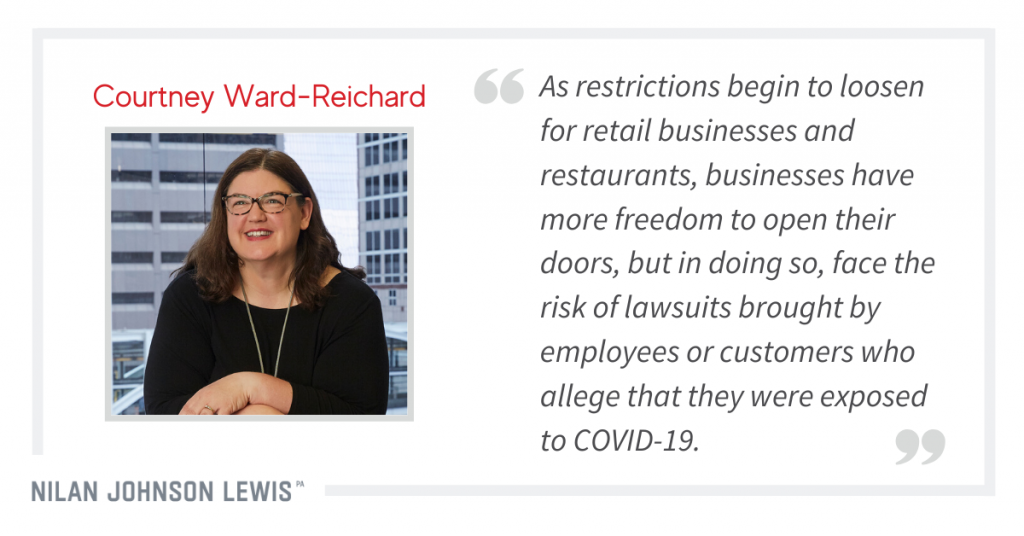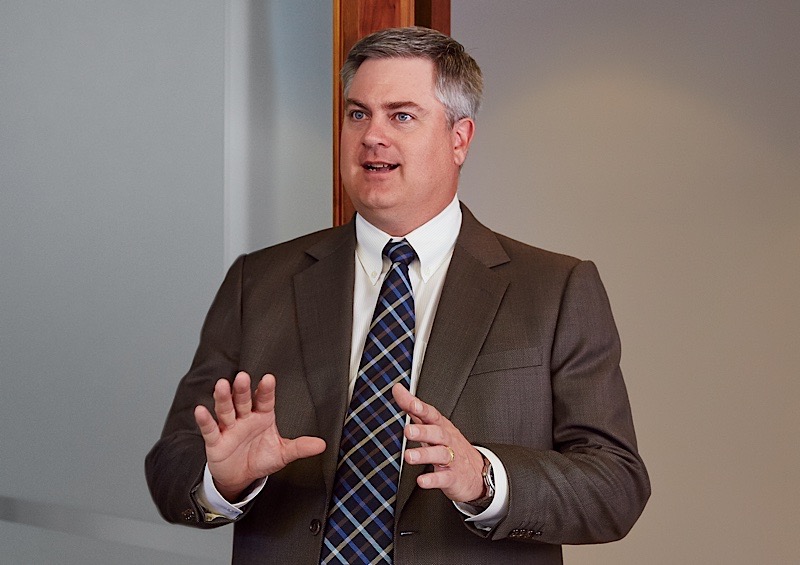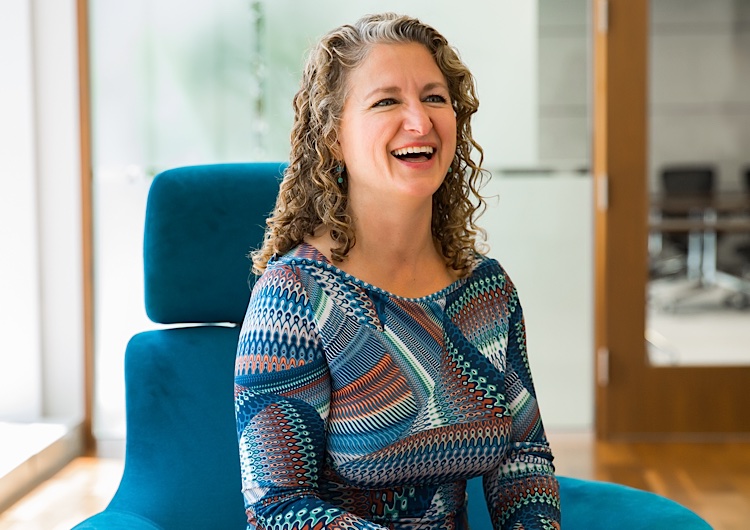
Posted June 5th, 2020 in Top Stories, Legal Insights with Tags COVID-19 Products, COVID-19 Litigation, COVID-19
COVID-19: The Next Public Nuisance?
Retail businesses and restaurants have been devastated by stay-at-home orders intended to combat the COVID-19 epidemic. As restrictions begin to loosen, businesses have more freedom to open their doors, but in doing so, face the risk of lawsuits brought by employees or customers who allege that they were exposed to COVID-19.
Recent class-action lawsuits filed against Amazon, McDonald’s, and Smithfield Foods allege public nuisance, a common-law tort claim that has been used with varying degrees of success in mass tort and environmental litigation. Lawsuits asserting negligence or strict liability face a number of barriers – challenges in establishing causation and workers’ compensation bars among them. But public nuisance provides a potential path to avoid some of these barriers.
While the complaints filed so far are limited to employees, public nuisance claims could be brought by customers at any business open to the public, including stores and restaurants. Public nuisance has struggled to gain a foothold as a cause of action in other contexts and will face significant hurdles here as well, especially for businesses taking reasonable steps to protect employee and customer safety. But these claims could pose a serious threat as businesses seek to navigate the “new normal.”
Public Nuisance in the Age of COVD-19
The public nuisance lawsuits filed thus far focus on employees and their families – alleging that unsafe work conditions caused employees and their family members to contract the virus.
The first of these suits was filed in late April against Smithfield Foods in Missouri. This lawsuit alleged that workers at a pork processing plant were required to stand too close together, unable to sanitize themselves or their work areas, and not able to take sick leave. This suit was filed in Federal Court and has already been dismissed on the grounds that OSHA and other regulatory agencies have primary jurisdiction over safety issues at the plant.
The second suit was filed against McDonald’s in May, by employees of four McDonald’s restaurants in Chicago, as well as their family members. The employees allege that McDonald’s failed to provide adequate safety training or protective equipment, and forced them to work near co-workers and customers who were asymptomatic carriers. The family members allege that they were exposed to the virus when infected employees came home. On June 3, the Cook County court denied McDonald’s motion to dismiss on the grounds that regulatory agencies have primary jurisdiction, paving the way for the public nuisance claims to proceed. On June 4, a hearing was held on plaintiffs’ request for a preliminary injunction, requiring the restaurants to institute protective protocols. That hearing will continue on June 10.
Finally, on June 3, a public nuisance complaint was filed against Amazon in New York, alleging that the company failed to provide a safe workplace at a processing center in Staten Island by not enforcing proper hygiene or social distancing. The complaint contains serious injury allegations, including one employee death, and a named plaintiff who alleges that she contracted the virus while working at Amazon, and then infected members of her family, including a cousin who died. Plaintiffs allege that the company prevented workers from washing their hands and sanitizing their workspaces and that Amazon encouraged employees to continue coming to work by failing to pay quarantine leave.
What is Public Nuisance?
Public nuisance is one of the oldest common law causes of action, existing for hundreds of years. A public nuisance is commonly defined as “an unreasonable interference with a right common to the general public.” Restatement (Second) of Torts § 821B(1). It was traditionally an equitable remedy relating exclusively to the use of land and was typically brought by governmental entities.
Individuals may only bring public nuisance claims if they can establish “special injury” – a loss or injury that is different from the harm suffered by the rest of the community. A classic example of a public nuisance cause of action brought by an individual plaintiff is a neighbor who brings a claim against the owner of a noxious feedlot. The bad odor of the feedlot affects anyone who passes by, but next-door neighbors have uniquely lost the use and enjoyment of their property.
In the 1990s, creative plaintiff’s attorneys began asserting public nuisance claims in mass tort cases in an effort to avoid some of the burdens of proof required for strict liability and negligence claims. These efforts were largely unsuccessful, but the use of public nuisance claims has continued to expand, including products such as asbestos, lead paint, firearms, tobacco, and opioids. And there have been some notable successes: in a lawsuit against former manufacturers of lead pigment by a group of California counties and municipalities, and some opioid cases.
Defenses to Public Nuisance Claims in the Context of COVID-19
There are generally four basic elements to claims of public nuisance: the existence of a public right, a substantial and unreasonable interference with that right, proximate cause, and injury. But these elements are less well-defined than in other causes of action, which is part of the appeal for plaintiffs.
Reasonable Safety Measures
Perhaps the strongest argument against the use of public nuisance in this context is the use of reasonable protective measures. The lawsuit against Smithfield Foods was dismissed because of OSHA’s administrative authority, but the Court’s opinion also noted that the public nuisance claims were unlikely to prevail:
The issue is whether the Plant, as it is currently operating, constitutes an offense against the public order. Because of the significant measures Smithfield has implemented to combat the disease and the lack of COVID-19 at the facility, the Plant cannot be said to violate the public’s right to health and safety. Thus, the Court finds that Plaintiffs are unlikely to succeed on their public nuisance claim.
Rural Cmty. Workers All. v. Smithfield Foods, Inc., No. 5:20-CV-06063-DGK, 2020 WL 2145350, at *11 (W.D. Mo. May 5, 2020).
Of course, plaintiffs allege that the lack of protective measures constitutes the public nuisance, essentially arguing that the defendants failed to take reasonable safety measures. But the defendants will undoubtedly defend the cases by establishing the protections they did provide. As businesses reopen in the midst of COVID-19, following state and local guidance, and taking reasonable measures, will provide a strong defense.
Causation
Causation is another critical barrier to these suits, especially in the context of customers, but also with respect to claims by employees and their families. Even though some traditional tort requirements are lacking in public nuisance claims, the requirement of proximate cause is still required.
Proving the source of infection could prove difficult. For instance, the very first paragraph of the Amazon complaint alleges that Amazon employs workers “who travel hours every day by public transportation,” seemingly establishing a possible alternate mode of transmission from the start. The burden will be even higher with respect to a family member of an employee and could be insurmountable with respect to a customer of a store.
Lack of Control
Control over the nuisance is another potential defense. This is used most effectively in products cases, such as in lead paint litigation, where manufacturers argued that they were not in control of the alleged nuisance at the time it caused harm. The arguments are a bit different in this context – the defendants do have control over the premises, but do not have control over the virus or potentially over the actions of employees or customers.
Public Policy
Finally, a strong defense is presented by public policy: public nuisance claims are vague and amorphous, and there are other more appropriate causes of action and remedies in this context, OSHA regulations and Worker’s Compensation among them. This has been the basis for rejecting public nuisance claims in many products liability suits, with concerns that to allow such claims would essentially rewrite tort law, and open the floodgates to meritless claims involving virtually anything that causes harm.
Similar concerns exist here. The COVID-19 pandemic may suggest that these cases are novel, but they really are not: they are questions of how businesses protect employee and customer safety. It’s easy to imagine how public nuisance could be alleged in cases such as an employee injury on a dangerous piece of manufacturing equipment, or a customer slip and fall in an icy parking lot. Public policy suggests that regulatory and legal schemes that already exist to address these types of injuries should prevail.
Conclusion
The best advice for any business is to take reasonable measures to protect employees and the public during the COVID-19 outbreak. Lawsuits are certainly a risk, and public nuisance claims create an additional potential threat. But, defenses are strong, and it seems unlikely that courts will turn to the law of public nuisance instead of regulatory schemes and more typical causes of action.




